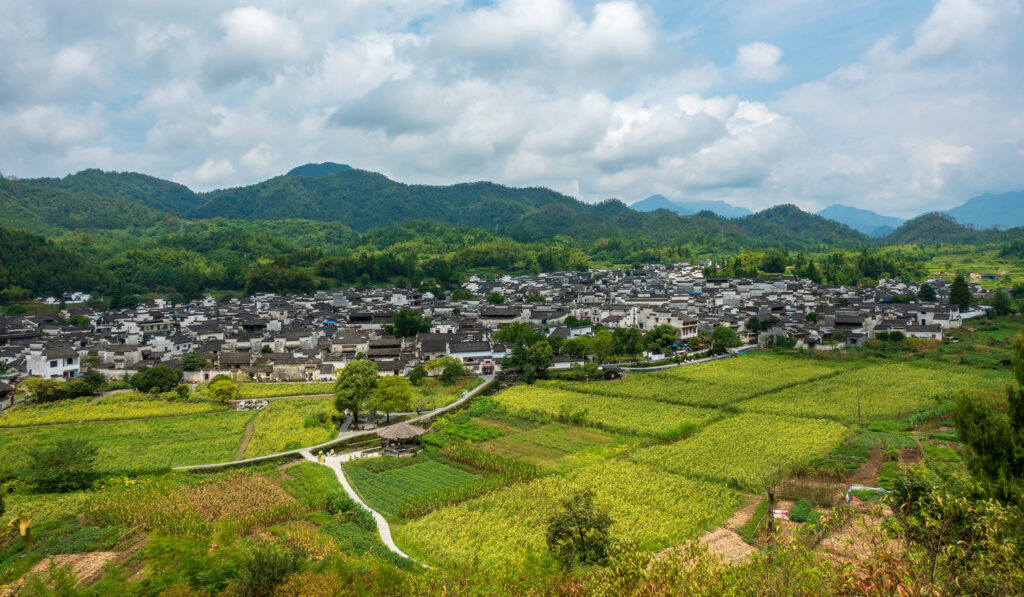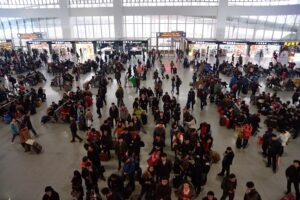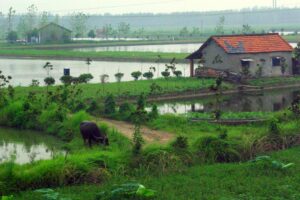FOR POLICYMAKERS IN THE People’s Republic of China (PRC), the location and timing of the COVID-19 outbreak were disastrous. Wuhan, the sprawling capital of Hubei province, with eleven million residents, is inland China’s largest land and air transportation hub and a major shipping port on the Yangtze River .1 In 2013, Wuhan’s railway passenger traffic of 120 million surpassed that of Beijing, making it China’s largest railway transfer station.2 The city has thus become a main hub for China’s high-speed rail network, sitting on the busy Beijing–Guangzhou and Hu–Han–Rong (Shanghai–Chengdu) lines.
Even worse than the location was the timing. The virus began to spread in Wuhan on the cusp of China’s Lunar New Year holiday, when hundreds of millions of migrant workers leave cities like Wuhan and travel long distances on trains and buses to their rural homes for some well-deserved rest with their families.
On 23 January, the day before New Year’s Eve, Wuhan was officially locked down — halting all travel in and out of the city. Yet this decisive move may have come too late. In the preceding weeks, some five million people left Wuhan for the New Year holiday, many of them migrant workers returning to their rural villages.3 Travel was, as usual, intense: on 23 January alone, some 251 long-distance trains departed or passed through Wuhan between midnight and 10 am.4
Travellers departing Wuhan sat on trains and buses alongside many of China’s 135 million migrants who work ‘temporarily’ in cities along China’s crowded eastern seaboard during the year.5 This year, from 9 to 24 January, China’s railways carried 1.143 billion passengers, many of whom were migrant workers returning home for the holidays.6 Millions of people thus passed through Wuhan or travelled alongside Wuhan residents before returning home, potentially spreading the virus throughout the country’s populous agricultural regions.7
Remarkably, the provinces surrounding Hubei did not experience a virus outbreak.8 From the 23 January lockdown of Wuhan until its reopening on 8 April, China had a total of 81,865 COVID-19 infections. Of these cases, 67,803 (83 percent) were in Hubei, with Wuhan accounting for 50,008 cases, representing 61 percent of total cases across China.9
The low number of cases recorded in provinces adjacent to Hubei was particularly surprising. For instance, as of 8 April, Hunan had only 1,019 cases10 in a total population of sixty-nine million, 60 percent of whom live in rural areas.11 Henan province is even larger — with ninety-six million residents, 67 percent of them rural — and yet it saw only 1,276 cases during the same period.12
In short, even though massive numbers of rural migrants flowed rapidly in and out of Wuhan during this critical period, the adjacent rural regions did not experience large-scale infections. What prevented this potential disaster?
State Control or Good Governance?
To date, most studies of China’s control of the virus have focused on governance capacity or state control. Chinese scholars have generally credited China’s effective containment to the state’s capacity to make rapid policy decisions in the face of uncertainty, which proved impressive after the initial delays in Wuhan.13 Others have praised China’s ‘responsibility system’, which allocates authority to different functional and regional entities, for facilitating the rapid mobilisation of China’s vast governance system.14 After a ‘chaotic’ start, as Ciqi Mei 梅赐琪 explains, a ‘policy mix of traditional measures’ aligned with China’s ‘policy style’ of ‘a centralised leadership, bureaucratic mobilisation, and memories of the right policy mix of previous crises’ proved effective.15
While acknowledging these governance tactics, Western analysts have instead tended to highlight political or state control, pointing to Beijing’s willingness to employ coercive tactics, surveillance and propaganda.16 But, coercion alone is an inadequate explanation. Financing and organising the logistics around food and medical supplies, for instance, also required institutional capacity. Others have turned to cultural explanations, suggesting that factors common to East Asian societies such as a strong sense of civic responsibility and caution help explain China’s success.17
In most of these studies, the focus has been on urban China. Yet unlike South Korea and Japan, which have small rural populations in percentage terms (Japan, 8 percent; South Korea, 19 percent),18 more than 55 percent of China’s population are rural residents,19 many of whom travel annually between urban jobs and family farms. In one of the few studies addressing rural migrants, social anthropologist Xiang Biao 项飙 argues, perhaps counter-intuitively, that the mobility of China’s migrant workers might have helped curtail the epidemic, as outmigration may have reduced urban infection rates and demands on urban medical resources.20 Yet if their destination region had limited medical facilities, as is the case in most of rural China, a massive population movement into the countryside could have risked spreading the virus into areas with limited coping capacity.
A more useful way to understand the experience of rural China amid the COVID-19 crisis is to consider the role of established social and institutional structures in helping both the Chinese state and Chinese society control the spread of the virus while minimising the economic impact of public health measures.
One of the most valuable, though widely overlooked, institutional structures has been the system of collective landownership in rural China. Almost half of China’s landmass is governed by a collectively owned land regime.21 Neither fully private nor fully state owned, most rural land is still owned by members of rural collectives — namely, China’s rural residents. By virtue of their membership within a collective — usually a village ‘group’ (VG) 村小组 — individuals who hold a ‘rural collective residence permit’ 农村集体户口 gain the right to use or rent out their allocated plot of farmland but cannot sell it off.
During the crisis, two features of China’s distinctive rural land regime proved particularly useful. In the first few months of the outbreak, the role of VG leaders was critical. VG leaders helped implement public health measures at the local level, while VG members policed the group’s territorial boundaries, ensuring limited social movement while maintaining social distancing practices. The group-based territorial structures, encompassing family homes, farms, and collective spaces, enabled most rural residents to maintain a largely normal existence while still limiting their social interactions.
The second key factor was the nature of land rights for rural residents. Rural households maintained their access to housing and agricultural land with minimal expense requirements, enabling them to meet their family’s basic needs without relying on government support. The central government could thus direct more of its financial resources towards controlling the virus, supporting urban residents, and restoring employment and economic growth. The rural land system thus played a crucial role in enabling China’s virus response.

Rural groups are generally acquaintance communities which know their local territory very well
Source: Achim Höfling, Flickr
Groups, Territory, and Staying Home in Rural China
Two of the most important policy measures used to control the spread of the virus were social distancing and shelter-in-place orders. In rural China, with a highly dispersed population and limited resources provided by the state, implementing these measures was far more difficult than in the cities.
In provinces such as Hunan, rural township populations range from 5,000 to 40,000 people, with most around 20,000.22 Yet only townships with a population of more than 20,000 are awarded their own police station, which are generally staffed with between five and fifteen officers, at most.23 Below the township level, governance capacity is even lower. Villages, which tend to have at least several hundred residents, rely on a few local residents who serve on village committees 村委会 for local governance. As widely noted in Chinese media at the time, these local officials had neither adequate training nor adequate resources to implement the governance measures required for effective virus control.24
Furthermore, due to the public ownership of rural land, the boundaries of Chinese farms are not clearly delineated. Years ago, when driving through the central United States, I remember being struck by the ubiquitous fences separating the endless fields of corn. In contrast, most Chinese villages and fields are not fenced off. Therefore, rural officials could not establish anything like the system of barriers used in Chinese cities to limit movement. Most Chinese urban residential developments
小区 have external walls and/or can easily construct fences or barriers, with guards at all entrances, to effectively enclose an entire neighbourhood. While local people could block a rural village’s main roads, they would have been unable to build barriers enclosing the entire village, particularly if it was surrounded by fields or hills.
Given the limited governance capacity and difficulties of establishing territorial barriers in rural China, how did rural cadres manage to ensure rural residents stayed at home and maintained social distancing requirements for the crucial first two months after the Wuhan outbreak?
Again, VGs were a key factor. There are 2.385 million VGs in China.25 For most of rural China, the VG is the entity that holds the collective rights to the group’s allocated land. This land is then further subdivided among all of the VG members, providing each family’s allocated land for farming and living. While these VGs do not have any formal administrative or economic functions within China’s governance structure, three of their features were particularly salient for enforcing shelter-in-place orders and ensuring rural residents maintained social distancing requirements.
First, each VG is essentially an extended ‘acquaintance community’ — the phrase developed by the influential sociologist Fei Xiaotong
费孝通 (1910–2005) to describe the dense interpersonal networks that characterise Chinese villages.26 Close social linkages make it easy for VG leaders to contact all members of their VG. A member of the village committee, for instance, could be responsible for contacting the leaders of all VGs to ask whether anyone in their group had been to Wuhan. The VG leaders are not only residents, but also have extended family members within the group. These leaders would likely be familiar with all families within their VG, and so could contact them quickly and easily, while requesting that they take (or avoid) certain actions and help monitor the implementation of key measures by all group members.
The diary of one village committee leader provides an insightful example of how VG-level epidemic control proved effective.27 The village leader first contacted all VG leaders, asking each to tell the families in their group who had family members recently returned from a city to isolate themselves at home. Thermometers were distributed to each VG and then to households with members who had recently returned from a city. Each VG leader was asked to ensure that these households were doing daily temperature checks and providing these results to village officials. This proved effective and efficient. If village officials or doctors had to visit each home daily to conduct temperature checks, this not only would have been time and resource intensive, but also would have risked spreading the virus further.
Second, the territorial basis of VGs ensures that all group members are well aware of where their collective territory ends, even without any formal geographical markers. This meant that VG members could — and did — easily and collectively monitor any non-group members attempting to enter their territory. This explains why, during the lockdown period, simple boundary markers such as a red cloth, a pile of dirt or a handwritten sign were sufficient to indicate the dividing lines between different groups’ territories.28 Since each group has a common interest in maintaining the well-being of all its members, they co-operated in limiting entry by people from other groups while effectively supervising their own members’ movements.
Finally, because each group’s territory includes farming land, land for their homes, and shared zones for leisure, group members could carry on with their lives while still maintaining social distancing between households. Having this common territory meant that group members could continue to farm, spend time outside, engage in local trading activities and even play Chinese chess 象棋, while still maintaining the key policy measures of sheltering in place and social distancing from non-household members.
Access to Land, Fiscal Relief and the COVID-19 Crisis
China’s collective rural land system also played a crucial buffering role during the lockdown period, enabling rural households to maintain their basic housing and food requirements without relying on financial support from the government. As a result, the central government did not have to expand its fiscal expenditure to support rural residents or unemployed migrant workers returning to the countryside. Instead, it was able to direct its scarce resources towards containing the epidemic in urban communities.
The income structure of most Chinese rural households features four main sources: wage income, operational income, income from property and income from government direct transfers. A large portion of wage income comes from informal economic activities, while operational income generally derives from cultivating farmland. For the average rural resident in 2019, wages provided about 41 percent of their total income, while income from land production provided 36 percent.29 The mobility restrictions under shelter-in-place orders hit hardest for rural households that rely heavily on wage income earned by working in cities.30 However, these measures had limited impact on rural households’ farming income, due to four key attributes of China’s collective rural land system.
First, households do not need to pay anything to maintain their access to land. Since rural land is not taxed and farmers cannot take out loans using their homes or farms as collateral, they are not in danger of losing these due to income loss. Second, since farmers’ land is generally quite close to their residential land, mobility restrictions did not stop them farming. Third, although each family’s plot may be modest in scale, it is generally adequate to ensure food security for all household members, including urban returnees. Finally, there are no taxes on the sale of grain products, so farmers can retain all the profits from selling their grain. Although the wage income of rural households declined sharply during the COVID-19 crisis, these features of the rural land system made it financially easier for farmers to remain safely at home for an extended period.
For many city-based migrant workers who lost their jobs or suffered reduced incomes during the crisis, they at least retained the option of returning to their family farms, where they could meet their basic needs. For many, this might have been their final or only resort. For instance, rural women migrants working in an urban beauty salon usually work during the day and at night sleep on the salon’s beds to save on rent. When such businesses closed, their workers lost their housing as well as their jobs. Most migrant workers in small businesses were not covered by any urban welfare support during the crisis. Women who were fortunate enough to have kind parents or a good marriage were more likely to have retained their access to land.31 These women could return to their family farms in the countryside, and so at least maintain secure shelter and sustenance throughout the crisis.

Shandong, China, August 2020: Migrants working in a street-side beauty salon.
Source: Gauthier DELECROIX – 郭天, Flickr
Migrant workers who were able to remain in the city during the crisis might still have chosen to return home for several reasons. First, rural living expenses are modest compared with those in the city. Second, while rural incomes are low, life on the farm is often less stressful and less demanding than in the city. If they were fortunate, some returned migrant workers might have been able to find employment nearby or earn income through local construction tasks.32 This capacity for self-reliance was invaluable for the individuals involved and for the Chinese government as well.
For some wealthy countries, providing financial support helped businesses to keep their workers on the books while ensuring that recipients could and would abide by stay-at-home orders. But it has been very costly. Australia’s ‘JobKeeper’ payments, for instance, were designed to help six million people retain their jobs over the first six months of the COVID-19 crisis but came with a hefty price tag: AU$130 billion.33 If China had adopted a similar approach for just the most vulnerable migrant workers, the costs would also have been considerable. Based on an average per capita monthly income for migrant workers of 3,721 yuan, the fifty-two million migrant workers who returned home during the crisis would have suffered nearly 200 billion yuan (AU$41.3 billion) in lost income over just two months.34
For developed countries, the economic downturn has eroded fiscal revenue, while unemployment increases have driven up welfare expenditures. In Australia, the government faced massive additional expenditure in response to the crisis.35 Even as the government’s budget deficit has grown, it has faced pressure to maintain consistent levels of welfare provision.36 Meanwhile, the dual pressures of shrinking revenues and burgeoning expenses rendered the Australian government reluctant to fund some economic recovery measures that would have been socially desirable, such as building more public housing.37
The Chinese government faced the same fiscal problems of reduced revenue and increased expenditure during the crisis.38 With so many migrant workers losing their urban jobs, the pressure to provide financial support to rural households would have been high.39 If the Chinese government had provided 2,000 yuan per month (the minimum living requirements for a household of five people) over the two-month national shutdown for 600 million rural residents, this would have required at least 480 billion yuan (AU$99.2 billion). These non-payments represented a massive saving for China’s federal budget.
Instead of providing financial support to unemployed migrant workers through their employers to help retain jobs or providing welfare payments to low-income rural households to cover their minimum living expenses, the Chinese central government focused its financial support on fighting the epidemic, providing tax relief for urban businesses and making payment transfers to local authorities. China’s total funds for virus prevention and control reached 110.48 billion yuan by 4 March.40 In the first half of 2020, the central government’s transfer payments to local governments reached 6.28 trillion yuan, an increase of 1.26 trillion yuan over the same period the previous year. These funds were primarily used to protect the urban population: paying for staff wages at local public institutions, issuing social security payments for urban residents and helping meet the operational expenses of local governments.41 At the same time, the central government’s financial support to rural residents remained small and largely rhetorical. The government implemented a direct payment program for only 20,000 impoverished rural households. Instead, most official statements from the central government offered only vague pledges to ‘guide’, ‘discover’, ‘promote’, ‘support’, ‘place’, ‘attract’, and ‘encourage’ rural residents who faced considerable economic difficulties.42
By August, the situation in China was certainly looking better, with the virus largely under control, job growth turning positive and government budget revenue and tax revenue beginning to grow again.43 However, the burden that rural communities took on during the crisis in support of the state’s effort has tended to be taken for granted by the Chinese government and overlooked by many outside observers.
Conclusion
Generally speaking, effective governance rests on strong social and institutional foundations. Amid China’s COVID-19 crisis, two features of the rural collectively owned land regime proved crucial. First, village group–based territorial structures and strong community ties motivated local residents to police their own territorial boundaries. Furthermore, having family homes, farms, and collective spaces within the group’s territory helped rural families meet their housing and nutritional needs. As a result, the central government was able to direct its scarce resources towards urban communities and businesses while rural communities sustained key public health measures during the crisis.
The experiences in containing COVID-19 in rural China show that some of China’s distinctive social and institutional factors were effectively utilised to support key public health measures. However, while the rural land system proved invaluable in this case, it remains inadequate as a long-term solution for meeting the complex and changing welfare needs of rural households and rural-to-urban migrant workers, especially women. To date, the Chinese government’s fiscal policies have tended to favour urban residents and prioritise urban businesses and government agencies. With the Chinese economy now on the road to recovery, the government should expand its fiscal support for rural business, rural communities, and rural migrants working in cities.




